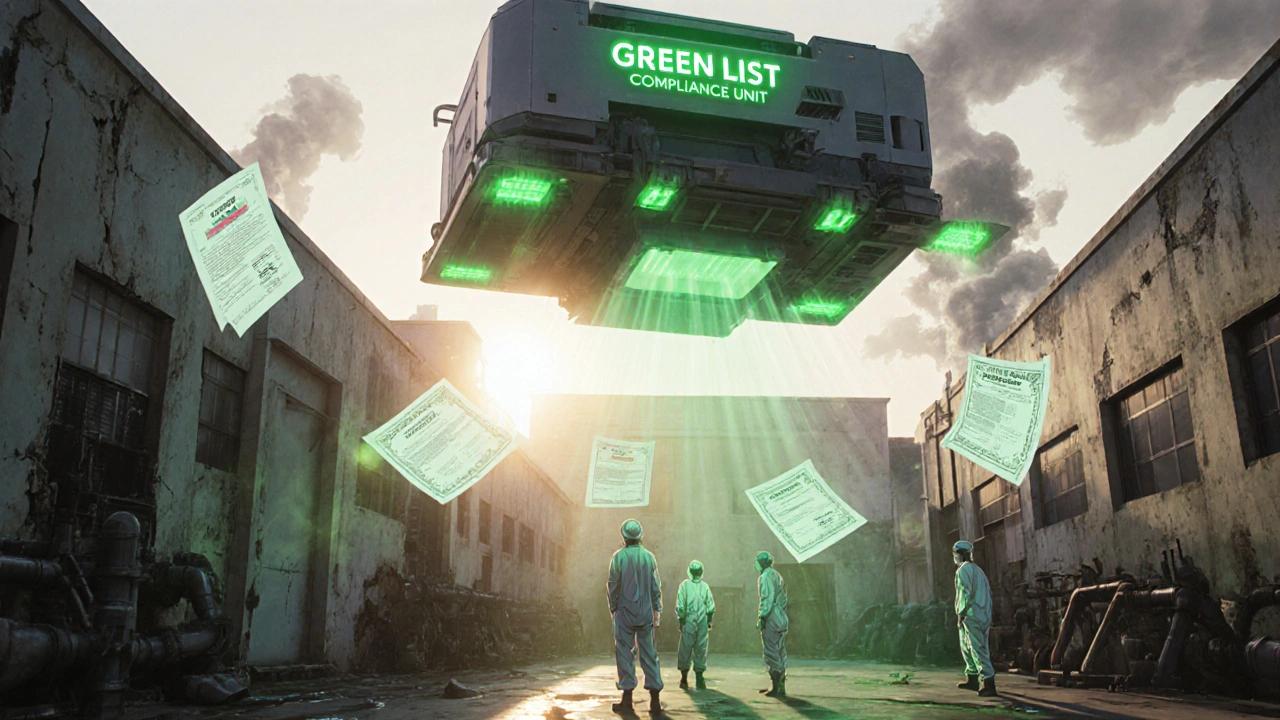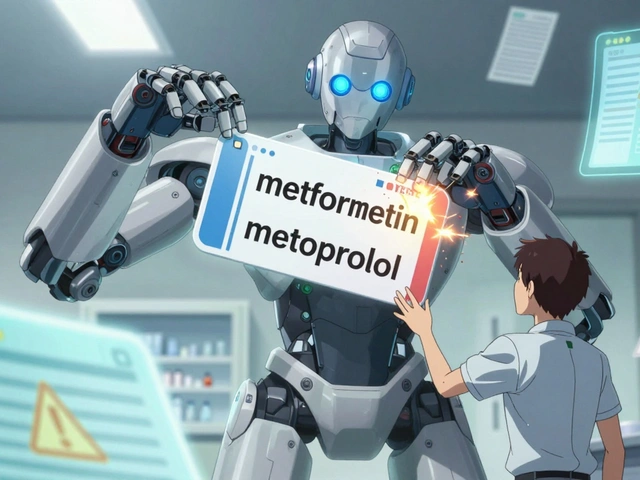The U.S. Food and Drug Administration (FDA) doesn’t wait for dangerous drugs to reach pharmacy shelves before acting. Instead, it stops them at the border-no inspection needed. Since September 2025, over 1,800 shipments of weight-loss drug ingredients like semaglutide and tirzepatide have been automatically seized at U.S. ports. Why? Because they came from manufacturers not on the FDA’s Green List. This isn’t random enforcement. It’s a system built over decades, now sharpened to cut off unsafe drugs before they even enter the country.
How Import Alerts Work: The Green, Yellow, and Red System
The FDA’s Import Alert system is a color-coded enforcement tool that flags manufacturers based on their track record. If a facility has a history of violations-like poor sanitation, falsified test results, or unapproved processes-it gets placed on the Yellow or Red List. Once there, every future shipment of its drugs is automatically detained without physical inspection. This is called Detention Without Physical Examination (DWPE).
On the other end, manufacturers who clean up their act and prove compliance can join the Green List. These companies get near-automatic clearance: 99.2% of their shipments pass through customs without delay. The difference between Green and Red isn’t just paperwork-it’s survival in the U.S. market. A single shipment from a non-listed facility can be held for weeks, costing hundreds of thousands in storage, legal fees, and lost sales. And if it’s rejected, the company has 90 days to either destroy the drugs or ship them out, or face penalties up to three times the product’s value.
As of November 2025, there are 238 active Import Alerts covering everything from antibiotics to insulin. But the most aggressive update came in September 2025: Import Alert 66-80, targeting GLP-1 receptor agonist APIs. This single alert has reshaped global supply chains overnight.
Why GLP-1 Drugs Became the Target
Weight-loss drugs like semaglutide (Ozempic, Wegovy) and tirzepatide (Mounjaro) exploded in popularity after 2022. Demand surged, but legitimate manufacturing couldn’t keep up. Enter unregulated suppliers-especially in India and China-offering bulk APIs at half the price. Many of these facilities had no FDA inspection history, no validated processes, and no real quality control.
By mid-2025, the FDA had evidence: 68.4% of seized GLP-1 shipments contained impurities above international safety limits. Some batches had wrong dosages. Others had toxic solvents left behind from poor manufacturing. One batch tested positive for a carcinogen linked to liver damage. The agency didn’t wait for more people to get sick. It acted.
The Green List was created to give compliant manufacturers a clear path forward. But it’s not easy to get on. You need:
- A full FDA-recognized third-party audit (cost: $45,000-$68,000)
- Stability testing across three temperature conditions
- Traceability from raw materials to finished product-down to Tier 3 suppliers
- Correctly formatted Certificates of Analysis (CoA)
Companies that skipped these steps are now losing millions. One Indian manufacturer reported a $1.2 million shipment seized simply because their auditor wasn’t FDA-approved-even though they had ISO 9001 certification. That certification doesn’t mean anything to the FDA if it’s not from a recognized auditor.

Who Gets Hit the Hardest
The impact isn’t spread evenly. Of the 89 facilities caught in the GLP-1 Import Alert, 73 are in India. Nine are in China. Seven are in Europe. India’s pharmaceutical industry, which supplies nearly 40% of U.S. generic drugs, is feeling the pressure. The Indian Pharmaceutical Alliance estimates 28,500 jobs are at risk across 47 facilities.
But it’s not just foreign manufacturers. U.S. companies importing these APIs are also being punished. Pharmacies and compounding centers that relied on cheap, unapproved ingredients now face shortages. Prices for compounded GLP-1 formulations jumped 14.3% in November 2025. Some patients are turning to illegal online sellers-where the risk of counterfeit drugs is even higher.
Big pharma is adapting fast. Novo Nordisk’s approved suppliers gained 18.7% market share in six weeks. Pfizer deployed blockchain traceability across 17 API suppliers, boosting their Green List acceptance rate to 99.8%. Catalent bought Novasep’s peptide business for $980 million specifically to control its own API supply. The message is clear: if you can’t prove compliance, you won’t get access to the U.S. market.

The Hidden Costs and Loopholes
The system works-but it’s not perfect. Some companies are gaming it. ProPublica found 157 products have received enforcement discretion exemptions since 2013. Mylan/Viatris’ endoscopy equipment was exempted 14 times despite repeated facility violations. Shilpa Medicare’s diabetes meds were exempted seven times in 2024. These exemptions undermine trust in the system.
Another issue: the 90-day destruction window. Some companies are paying brokers to falsify export paperwork instead of destroying their goods. The FDA issued Warning Letter 541598 in October 2025 to a Singaporean intermediary caught doing exactly that.
And then there’s the time lag. Getting off an Import Alert takes, on average, 11.7 months. That’s longer than Health Canada’s 6.3 months. One manufacturer spent 22 months trying to get back on the Green List after fixing their facility. They had to submit three consecutive compliant shipments, each verified by the FDA. They also had to submit video proof of their corrective actions-something only 13% of applicants thought they needed to do. Those who did? 87.4% got approved.
What Comes Next
The FDA isn’t stopping with GLP-1 drugs. In November 2025, Commissioner Dr. Robert Califf announced the same import alert framework will be extended to all high-risk biologics starting in Q1 2026. That includes monoclonal antibodies used for cancer, autoimmune diseases, and rare disorders.
Global regulators are following suit. The European Medicines Agency plans to adopt similar API screening protocols by mid-2026. China’s NMPA now requires all API exporters to meet FDA-equivalent facility certifications starting January 1, 2026. This isn’t just a U.S. rule anymore-it’s becoming the global standard.
For manufacturers, the cost of compliance is rising fast. McKinsey predicts 65-75% of global API producers will need to invest $500,000 to $2 million by 2027 to stay in the U.S. market. That means smaller suppliers will be squeezed out. Consolidation is inevitable.
The FDA’s Import Alert system isn’t about punishment. It’s about prevention. It’s about making sure the insulin, antibiotics, and weight-loss drugs people rely on don’t come from factories with dirty floors, untrained staff, or falsified records. The cost of compliance is high. But the cost of failure-patients getting sick or dying-is higher.
If you’re importing pharmaceuticals into the U.S., the message is simple: get on the Green List-or get out.
What happens if my drug shipment is detained under an FDA Import Alert?
If your shipment is detained under an Import Alert, it’s held at the port of entry without physical inspection. You have 90 days to either export the product or destroy it under FDA and Customs supervision. You can also submit a request for release by proving compliance-this includes a full corrective action plan, third-party audit reports, updated Certificates of Analysis, and evidence that the facility has fixed its violations. Without this, the shipment will be destroyed or returned.
How can a manufacturer get on the FDA Green List?
To get on the Green List, a manufacturer must undergo a comprehensive FDA-recognized third-party audit, complete stability testing under three conditions (2-8°C, 25°C/60% RH, and 40°C/75% RH), and provide full traceability of raw materials to finished product. They must also submit detailed documentation showing all violations have been corrected, including root cause analysis and CAPA (Corrective and Preventive Action) plans. The process takes 137±28 hours on average and costs $45,000-$68,000 in audit fees alone. Submitting video evidence of facility improvements increases approval chances by over 45%.
Why does the FDA use a color-coded system instead of a simple blacklist?
The color-coded system (Green, Yellow, Red) gives manufacturers a clear path to compliance. Unlike a simple blacklist, which cuts off access permanently, the Green List rewards improvement. A facility on Yellow can move to Green by fixing its issues and proving sustained compliance. This encourages reform instead of just punishment. It also allows the FDA to focus enforcement on the worst offenders while letting good actors continue business with minimal disruption.
Are there any exemptions to FDA Import Alerts?
Yes, but they’re rare and controversial. Since 2013, the FDA has granted enforcement discretion exemptions to 157 products, allowing them to bypass import alerts despite ongoing violations. Examples include Mylan/Viatris’ endoscopy equipment (exempted 14 times) and Shilpa Medicare’s diabetes drugs (exempted 7 times in 2024). These exemptions are granted on a case-by-case basis, often due to public health need, but they’ve raised concerns about fairness and enforcement consistency.
How does the FDA decide which manufacturers to target?
The FDA uses its PREDICT system, a risk-based algorithm that evaluates over 150 data points: inspection history, past refusal rates, product type risk, importer compliance records, and even supplier relationships. Facilities with repeated violations, unverified raw material sources, or falsified documentation are flagged. The system doesn’t rely on random checks-it predicts which shipments are most likely to be non-compliant based on historical patterns. This allows the FDA to detain shipments without inspecting them physically, saving time and resources.
What’s the impact on U.S. patients and pharmacies?
The crackdown has caused shortages of certain generic and compounded drugs, especially GLP-1 weight-loss medications. Prices for compounded versions rose 14.3% in November 2025. Some patients are turning to unregulated online sellers, where the risk of fake or contaminated drugs is higher. Pharmacies that relied on low-cost APIs are now scrambling to find compliant suppliers, often paying 2-3 times more. The goal is safety-but the short-term consequence is reduced access and higher costs for patients.







Leisha Haynes
November 22, 2025 AT 20:13So basically if you're a small pharma company in India and you can't afford a $68k audit you're just out of luck? 🤷♀️ The FDA's playing hardball but man this feels like a corporate power move disguised as safety
Shivam Goel
November 23, 2025 AT 07:18The data is irrefutable: 68.4% of seized GLP-1 shipments contained impurities exceeding ICH Q3B limits; furthermore, 23% exhibited residual solvents above ICH Q3C thresholds; additionally, 11.7% had incorrect potency profiles; moreover, 7.3% contained unapproved excipients; and critically, 3.1% tested positive for genotoxic impurities... this is not merely regulatory overreach-it is a public health imperative!
Andrew McAfee
November 23, 2025 AT 20:30You know what's wild? The same companies that got slapped with import alerts are the ones supplying 40% of our generic meds. So now we're gonna pay more for insulin because the FDA didn't want to inspect a factory in Hyderabad? It's not just about safety-it's about who gets to play in the game
Andrew Camacho
November 24, 2025 AT 22:16Let me get this straight-some Indian factory dumps solvent residue into a vial of semaglutide and the FDA says ‘nope’ but Mylan gets 14 exemptions? This isn’t regulation-it’s a rigged casino where your last name is your license to cheat. And don’t even get me started on how the FDA lets big pharma buy their way out of this mess with billion-dollar acquisitions. Pathetic.
Arup Kuri
November 26, 2025 AT 09:48This is all a distraction. The real agenda? The FDA and Big Pharma are working together to kill off cheap generics so they can jack up prices on Ozempic forever. You think they care about safety? They care about monopoly. That’s why they made the audit process impossible for small players. They don’t want competition. They want you dependent on their $1k/month shots
Elise Lakey
November 28, 2025 AT 02:17I’m curious-how many patients actually got sick from these seized shipments? I’m not saying the system shouldn’t exist, but I wonder if the fear of contamination is being used to justify economic exclusion. Is there data on adverse events tied to these specific manufacturers before the crackdown?
Erika Hunt
November 28, 2025 AT 03:14It’s fascinating how the color-coded system creates a behavioral incentive structure-it’s not just punitive, it’s rehabilitative, and that’s actually quite brilliant from a behavioral economics standpoint. The Yellow List acts as a nudge, a middle ground that allows for correction rather than immediate exclusion, which reduces resistance and increases long-term compliance. The psychological safety of knowing there’s a path back to Green is probably more effective than a permanent blacklist ever could be.
Srikanth BH
November 29, 2025 AT 00:11I work in pharma logistics in Hyderabad. I’ve seen factories fix their systems in 6 months. It’s hard but doable. The FDA’s process is brutal but fair-if you follow the steps, you get in. The problem isn’t the system. It’s that some companies think ISO 9001 means they’re done. It doesn’t. You need FDA-recognized auditors. That’s the real lesson here.
Jennifer Griffith
November 30, 2025 AT 15:49so like... if you're a compounding pharmacy and you bought some cheap semaglutide from a vendor who got flagged... are you in trouble too? like can they shut you down? this is getting wild
Roscoe Howard
December 1, 2025 AT 17:41The United States of America maintains the highest pharmaceutical safety standards in the history of human civilization. To suggest that this enforcement mechanism is anything other than a moral imperative is not only naive-it is an affront to the integrity of American public health policy. The global community must recognize that the FDA’s protocols are not merely regulatory-they are foundational to the preservation of life.
Kimberley Chronicle
December 3, 2025 AT 07:09The PREDICT algorithm’s use of Tier 3 supplier traceability is a game-changer in supply chain risk modeling. By incorporating upstream vendor compliance metrics into the risk scoring matrix, the FDA has effectively closed the loophole of subcontracted API synthesis. This is a paradigm shift from reactive enforcement to predictive risk mitigation-truly a masterclass in regulatory innovation.
Shirou Spade
December 4, 2025 AT 08:25We talk about safety, but we never ask: who decides what ‘safe’ means? Is it the FDA? Or is it the market? The Green List isn’t about science-it’s about power. The companies that can afford audits control the narrative. The rest? They’re just collateral in the war for profit. Maybe the real question is: should medicine be a privilege of wealth?
Lisa Odence
December 4, 2025 AT 08:35I just read that 87.4% of applicants who submitted video proof of facility upgrades got approved 😮💨 That’s wild. I mean, imagine having to film your factory cleaning the floors and then emailing it to the FDA like a TikTok challenge 🤯 But honestly? If it works, I’m all for it. Safety first, right? 💪🩺
Patricia McElhinney
December 5, 2025 AT 08:53The fact that the FDA allows enforcement discretion exemptions to Mylan and Shilpa-despite documented violations-is a catastrophic failure of oversight. This is not regulatory flexibility-it is institutional corruption. The public trust in pharmaceutical regulation is being systematically eroded by selective enforcement. This is not a system-it is a scandal.
Dolapo Eniola
December 5, 2025 AT 21:55Why is everyone acting like this is only about India? Nigeria makes 30% of Africa's generics. We’ve got factories that can meet FDA standards if given the chance. But you Americans just want to keep your market closed and charge us double. This isn’t safety-it’s economic colonialism. 🇳🇬💊
Agastya Shukla
December 6, 2025 AT 08:12The real issue isn't the Green List-it's the lack of transparency in how PREDICT weights data. We don’t know if a single failed inspection from 2018 still weighs as heavily as a new violation. Without open-source criteria, this system becomes a black box. Manufacturers are left guessing, and that’s not regulation-it’s arbitrary control.
Pallab Dasgupta
December 6, 2025 AT 11:58Bro. I saw a guy in Bangalore who turned his 10-person lab into an FDA-compliant facility in 8 months. He did the audit, filmed every step, hired a real auditor-not some guy with a LinkedIn profile-and now he’s shipping to the US. It’s hard? Yeah. But it’s not impossible. Stop blaming the FDA. Start fixing your factory.
Ellen Sales
December 6, 2025 AT 12:47The 90-day destruction window... it’s cruel. Imagine spending millions building a batch, shipping it across the world, only to be told you have three months to destroy it or pay triple the value. That’s not regulation. That’s financial execution. And yet, the FDA calls it ‘prevention.’ I wonder how many small companies just shut down instead of fighting. This system doesn’t just block bad drugs-it erases entire businesses.